· 6 min read
Popularity Of Mobile Game Art Styles And Genres – Data Breakdown
Erno Kiiski
Chief Game Analyst at GameRefinery
Editor’s Note: this post was originally published by Erno Kiiski, Chief Game Analyst at GameRefinery. In his job, he’s played and analyzed hundreds of titles on a feature level, giving him a strong sense of the current mobile game market.
This time round, our friends at GameRefinery take a look at the visual elements of top mobile games on the market. They take a deep dive into which game art styles and genres are rocking the US, Chinese and Japanese markets, breaking data down on a game category level to understand their popularity in different game types.
Before diving deeper, it’s good to understand how GameRefinery view the mobile game market in terms of genres and game types. In order to classify games in a meaningful way, they take into consideration games’ feature-set, theme and defining mechanics. This creates a three-layered taxonomy where every game has one (and only one) i) Category -> ii) Genre -> iii) Subgenre. For example, Summoners War would go under Mid-core -> RPG -> Turn-based RPG.
Here’s a visual representation of their categories, genres, and subgenres to help you get a better idea of the taxonomy. If you want to read more about their mobile game genre taxonomy, then make sure to check out their blog post on the topic! In this post, GameRefinery sticks to the (highest) category level when going through the data.
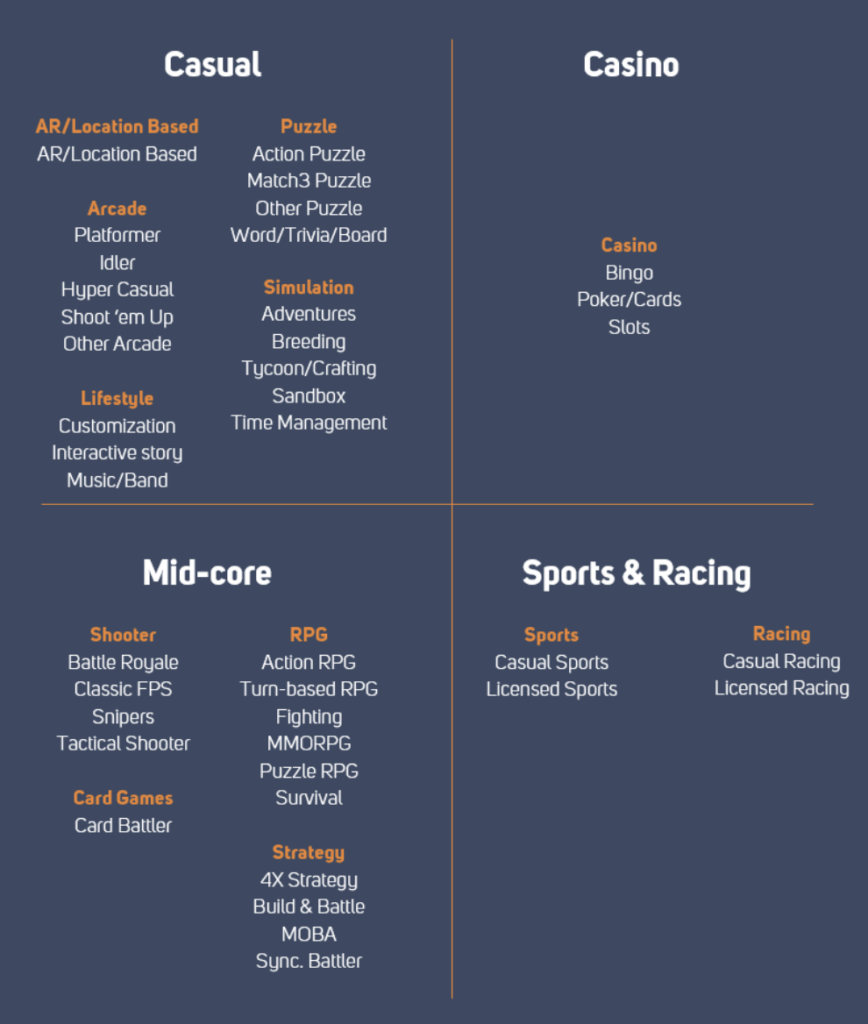
Genre taxonomy picture
So what are game art genres?
Game art genres describe the world and the era/age in which the game takes place.
For example, the artistic genre of a game about knights, castles, and catapults set in a realistic world similar to ours would be Realistic – Historic. But if there are also wizards, trolls and dragons, the genre would be Fantasy.
First, let’s get an overview of the 200 top grossing games in all three markets.

In the US, the market is dominated by the Realistic – Modern art genre which takes a 43% share of top games, followed by Fantasy and Other art genres. In comparison, the Fantasy genre dominates the Chinese market with almost half of top grossing games falling into that category. Japan is almost a mix of the two in terms of art genre popularity, with Realistic – Modern and Fantasy both holding a near even share of the market.
Comparison:
- Sci-fi’s not too hot of an art genre in any of the major markets.
- Realistic – Modern is much more popular in the US compared to Asian markets.
- Other includes games that don’t fit into any other genre, e.g. Angry Birds, and is more prevalent in the US than it is in Asia.
- In Asia, historic themes seem to be more popular (Three Kingdoms and Japanese Edo-era games are the most common).
- Hybrid themes (e.g., mixing Fantasy + Sci-fi) are more popular in Asian markets.
Breaking down game art genres into categories
Let’s now look at art genre stats in terms of our categories to see which art genres are popular in what kinds of games.
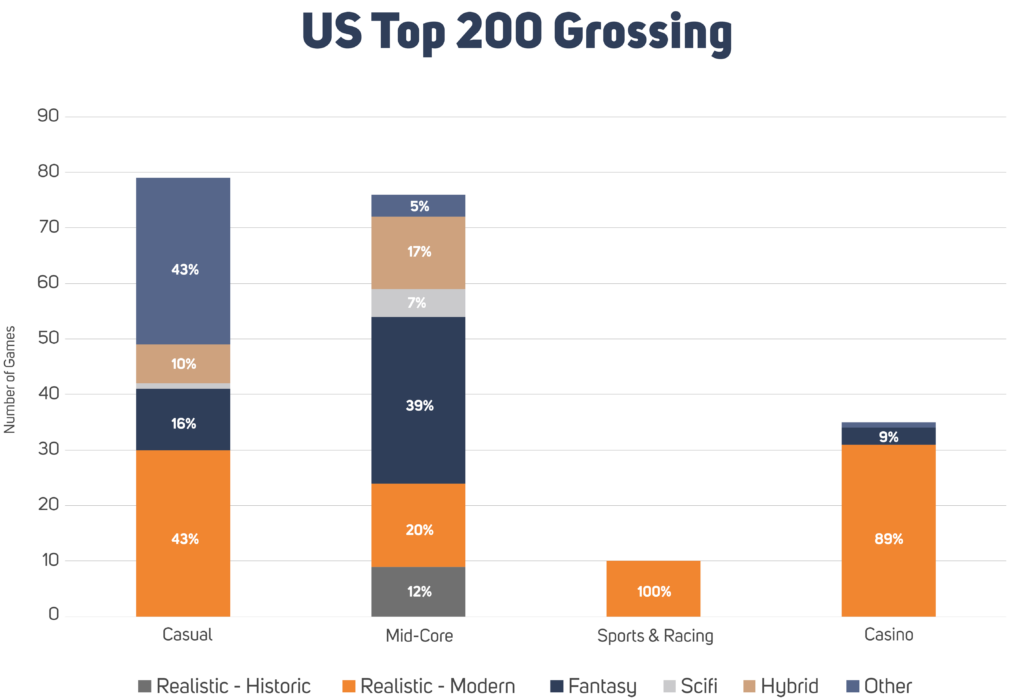

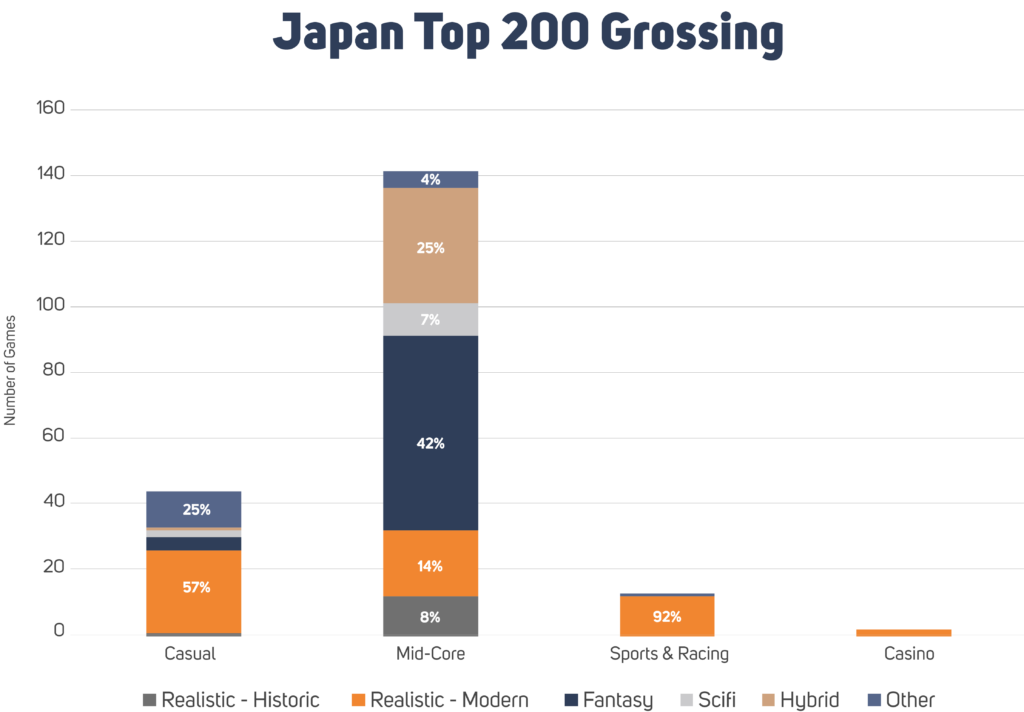
Comparison:
- Casual is bigger than Mid-Core in the US (in terms of the number of games in the top 200), but Japan and China are dominated by Mid-core games.
- Around 40% of Mid-core games in the US and Japan are Fantasy themed, but in China the number is even higher with over 60%.
- Hybrid games (where there’s a mix of different genres, e.g. Fantasy + Sci-fi) have the strongest showing in Japan, covering a fifth of Mid-core games.
- Sports & Racing games are dominated by Realistic-Modern across almost all markets. There are only a couple of games outside this art genre in all 3 markets combined.
- Pretty much all Realistic – Historic games are Mid-Core games
How about game art styles then?
Game art styles describe the visual style of characters, buildings, items, etc. within the game.
Let’s take another look at the top three markets.
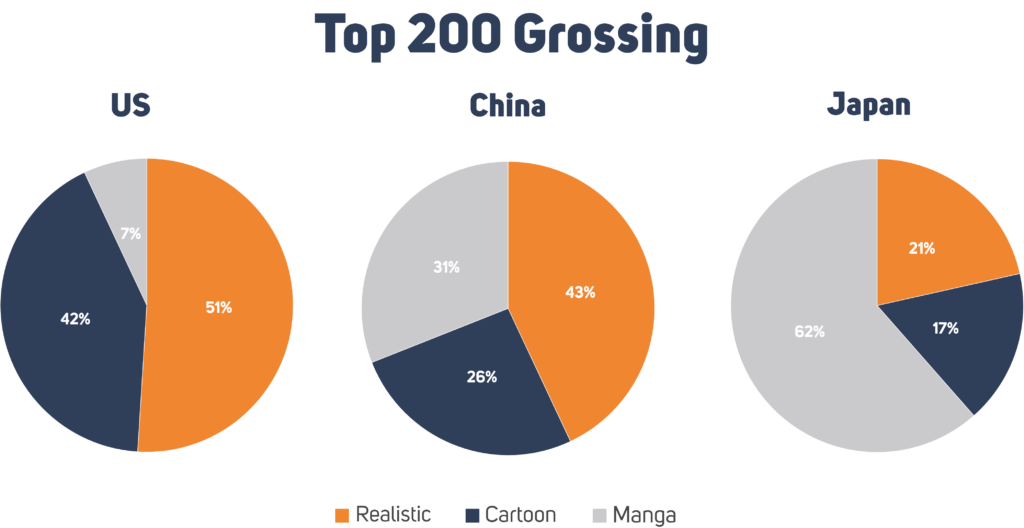
The US market is evenly split between Realistic and Cartoon game art styles, but Manga hasn’t been able to garner that much attention. The Chinese market is more equal in this regard, where the most significant share goes to Realistic with Manga and Cartoon following closely. In Japan, there’s one clear winner, Manga. It is the art style of choice in 62% of the top 200 games. The last 40% is pretty evenly shared by Realistic and “western” Cartoon styles.
Comparison:
- Manga rules Japan and has a significant share in China as well, but it only has a minor share in the US.
- The Cartoon style is easily the most popular in the US.
- Realistic is not even nearly as popular style choice in Japan than it is in US and China
Breaking down game art styles into categories
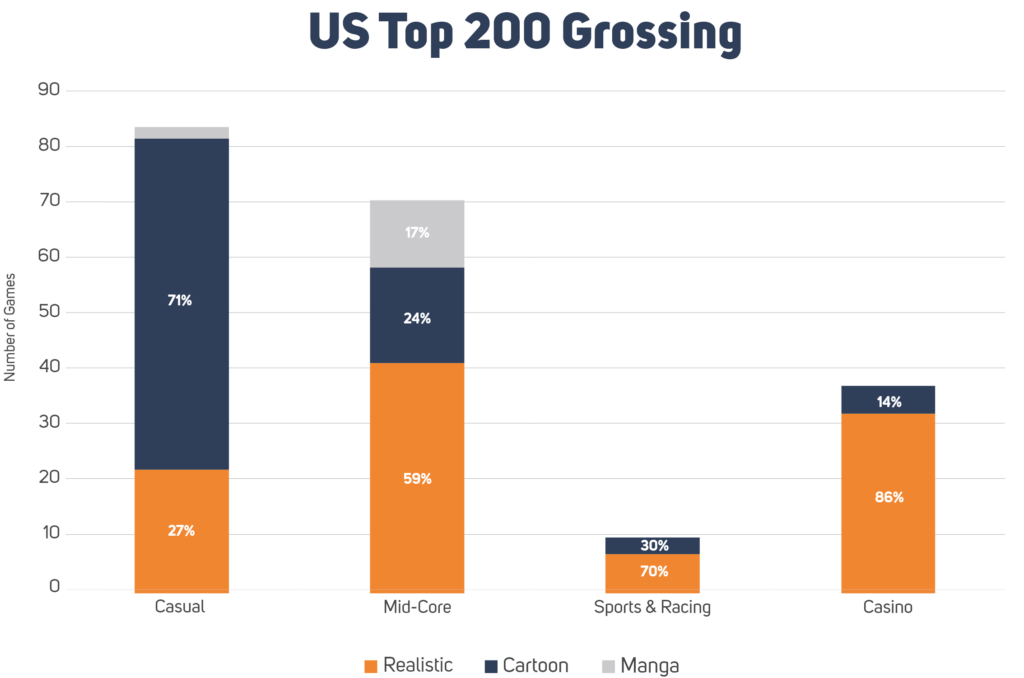
The Cartoon style dominates the US Casual market with over 71% share, whereas the Realistic style is the most popular in other categories.
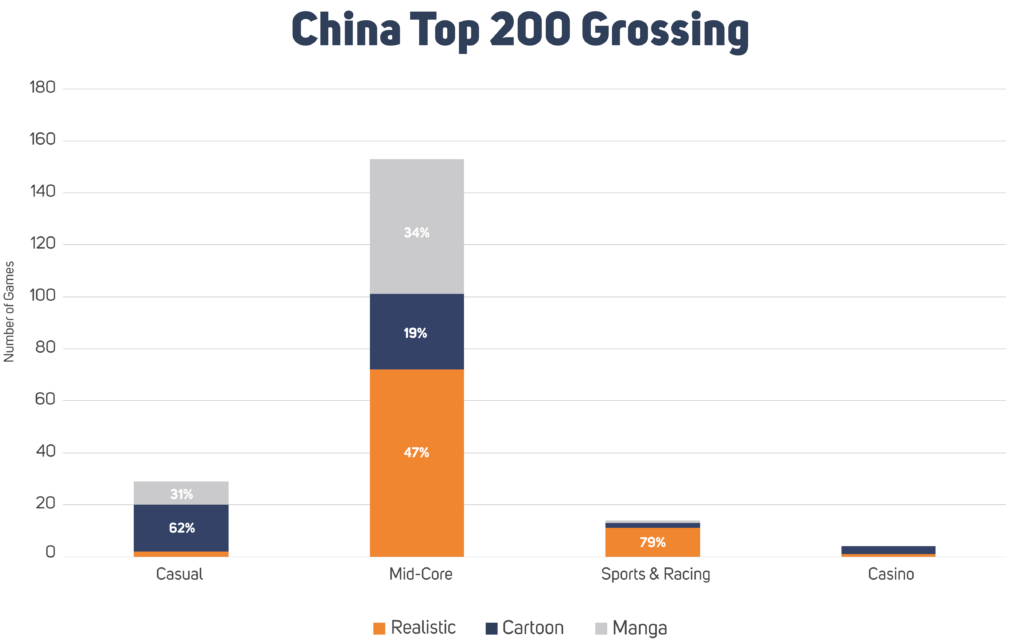
In China, Manga and Realistic game art styles are near equally represented in Mid-Core. But in Casual games, Cartoon and Manga are dominating and Realistic style art is almost non-existant.
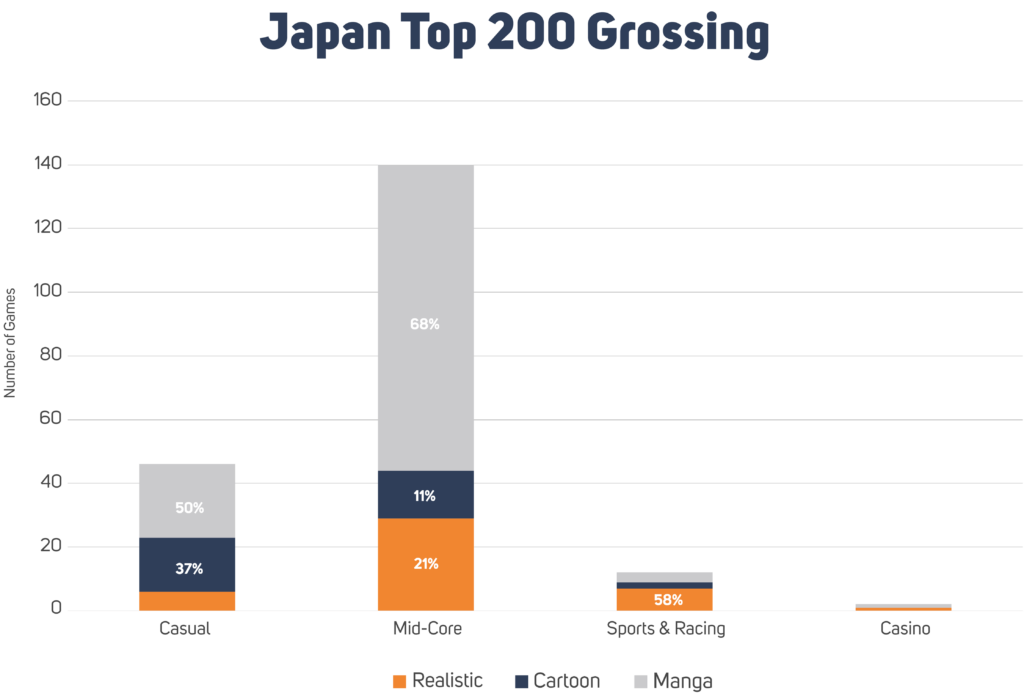
In Japan, Manga is easily the most prominent art style in the two biggest categories (Casual, Mid-Core).
Comparison:
- Casual games don’t use Realistic art almost at all in Asia, but in the US it has a 27% share.
- Only 58% of Sports & Racing games in Japan are Realistic when in the US and China the share is far more significant.
- Almost all of the US’ Manga styled games are Mid-Core games.
Art genre + art style
Finally, let’s look at art genres and art styles together.
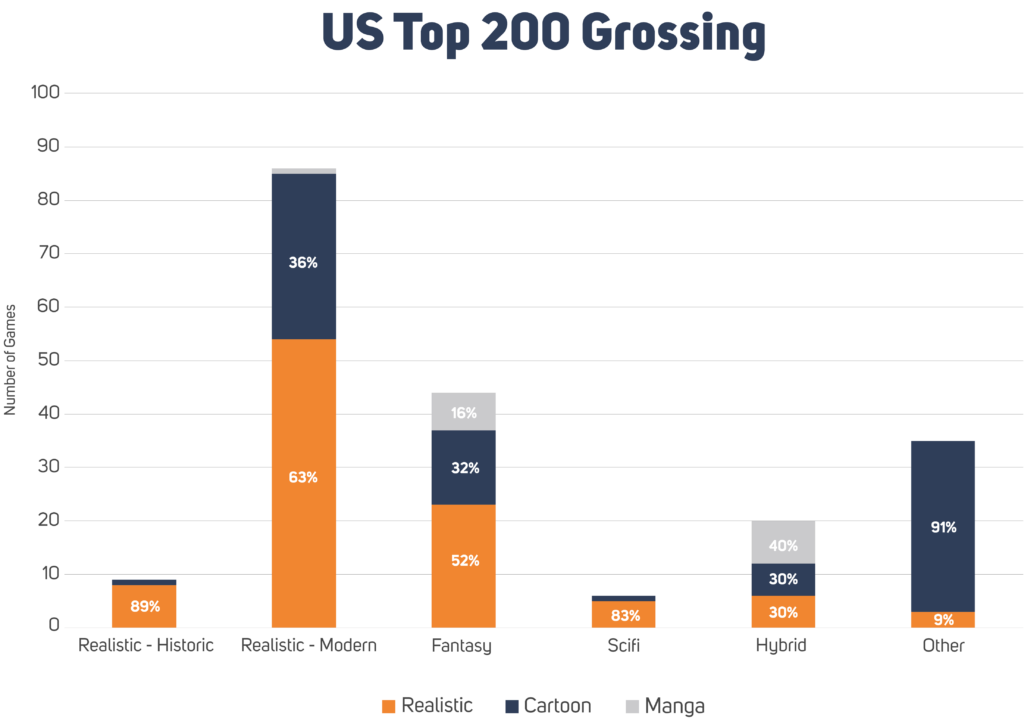
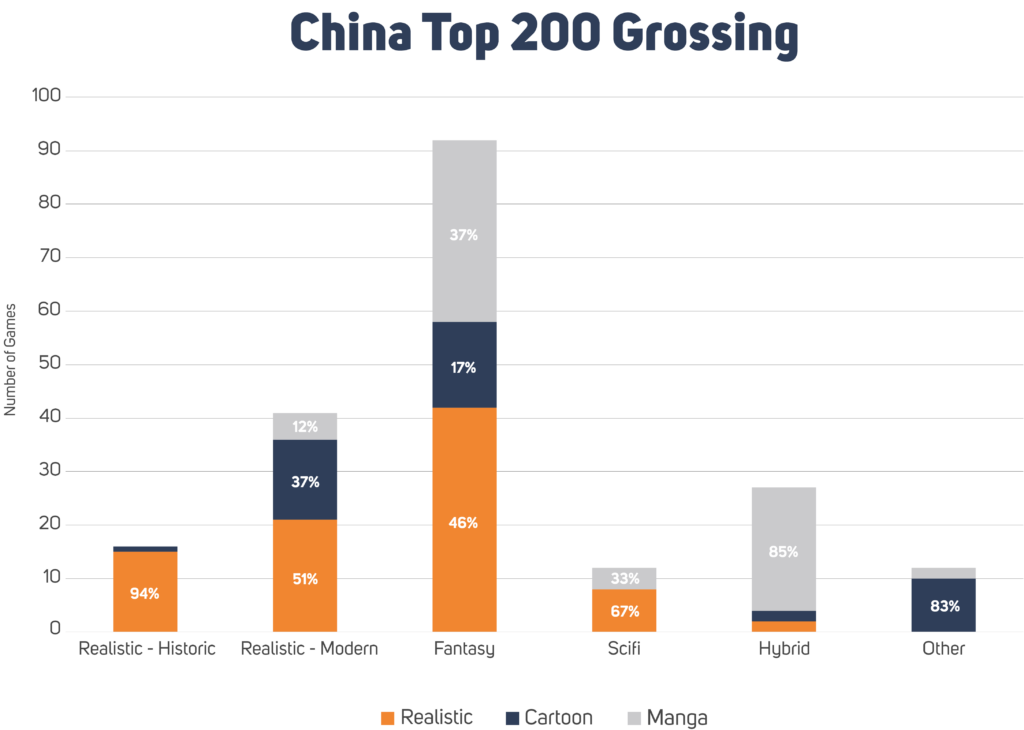

Comparison:
- Pretty much all Fantasy games in Japan are either Manga or Cartoon styled. In contrast, in the US and China, there are plenty of Fantasy games with Realistic graphics.
- Manga style is the most used in Hybrid games in all markets (even in the US).
- Interestingly very few Realistic – Historical or Sci-fi games have Cartoon art in any market.
- Games with Other art genre are more or less exclusively Cartoon styled.
Will we see a shift?
This research provides us with a general overview of the current market situation, but it’ll be interesting to see how the market develops over time. For example, will Mario Kart (releasing this summer) bring more Cartoon styled games to Sports & Racing in its wake? Or will we see a surge in the popularity of the Sci-figenre, which is quite popular in other entertainment mediums? Either way, we’ll be following developments closely here at GameRefinery.
Interested in doing market research of your own? You can use GameRefinery’s Market Explorer to mix and match any of over 200 mobile game features to conduct similar research with just a couple of clicks. Sign up here.
Fancy some more reading? Check out some of GameRefinery’s other articles: